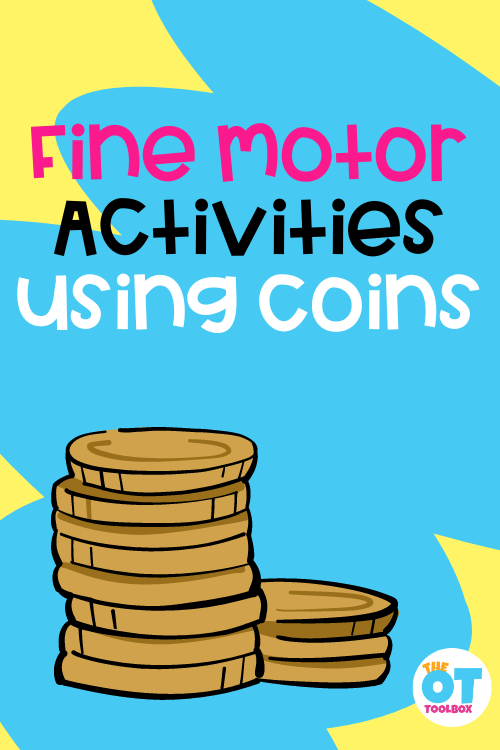Here we are covering all things bilateral coordination toys. When it comes to bilateral integration, coordinating both sides of the body in play can be a challenge for some children. These bilateral skills impact functional use of the body, motor planning, and bilateral integration as a whole. It’s through play with occupational therapy toys targeting bilateral skills that children can strengthen and develop this essential motor skill. Let’s dissect a few select toys that promote this skill.
Amazon affiliate links are included in this blog post. As an Amazon Influencer, I earn from qualifying purchases.
Bilateral Coordination Toys
We’ve previously covered both fine motor toy ideas and gross motor toys. Today’s topic closely mirrors those areas. Today is all about the bilateral integration that goes into motor play.
First, let’s talk Bilateral Coordination Toys!
Bilateral coordination toys are an occupational therapy intervention that helps children develop essential skills in bilateral integration. Toys that use both hands in a coordinated manner help children with bilateral coordination, crossing midline, and using both hands in tasks. These are essential skills that allow for an integration of both sides of the body, but more than that, bilateral coordination tells us that the brain is communicating effectively and sharing information between sides of the brain.
Today, I’m excited to share bilateral coordination toys and games to help support this essential skill.
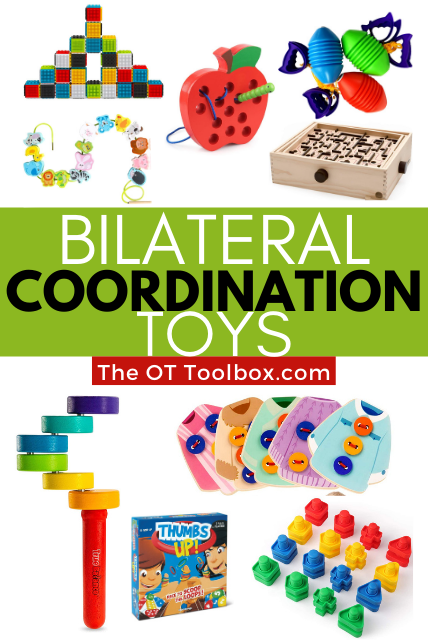
Bilateral integration
Bilateral coordination in functional tasks makes up much of our day! Think of all of the other areas where you are using both hands or both sides of the body at the same time: getting dressed, tying shoes, cooking, typing, holding a book while reading, pouring a glass of water…the list could go on and on!
Read about bilateral integration in the cross crawl exercise resource.
This integrated use of both sides of the body can be developed through play.
Using both sides of the body together is a skill needed for many tasks: writing with a pencil with one hand while stabilizing paper with the other hand is one such activity.
Another bilateral coordination task is cutting with scissors with one hand while holding and manipulating paper with the other hand.
For children with difficulty in crossing midline, or using integrated bilateral skills, using toys in play is an effective way to work on and nurture this skill.
Looking for a toy to work on bilateral coordination to add to your gift giving this holiday season? Today we are covering ways to build bilateral coordination skills using toys and everyday items. We also have another giveaway to share today. This time it’s a fine motor toy that promotes a variety of sills, bilateral integration being one of them. I wanted to highlight this as a toy for building bilateral coordination because as we know, promoting this skill is a valuable building block to other tasks such as handwriting, cutting with scissors, self-care tasks, and more.
Working on bilateral coordination in play is a means and a strategy for building this essential skill. So, why is bilateral coordination so important? And what exactly does bilateral coordination mean?
DIY Bilateral Coordination Toys
We’ve shared quite a few bilateral coordination toys and DIY activities here on this site in the past.
A bilateral coordination lacing plate is a DIY toy and activity that can be used to work on coordinated use of both hands with a variety of themes.
Using puzzles and games that you already have with an extra special addition can be a great way to work on bilateral coordination with puzzles.
Play dough and sensory doughs are fun ways to play while working on skills like bilateral coordination and other motor skills.
Stickers are an easy way to work on bilateral coordination and can be used in the classroom, clinic, or home and in combination with obstacle courses and other motor activities.
Pegboards (both DIY and store-bought versions), are a fantastic way to work on bilateral coordination in play and in developing visual motor skills and coordination.
DIY pick-up sticks are a fun way to address bilateral integration and coordinated use of both hands together.
Making DIY lacing cards are a fun way to work on bilateral coordination. Making the lacing cards is part of the fun.
Miniature rhythm sticks can be a musical and creative way to encourage bilateral coordination.
Lock and keys games like with this DIY lock and key activity makes fine motor development an out of the box way to work on skills kids need for independence and instrumental activities of daily living.
Bilateral Coordination Toys
There are many bilateral coordination toys on the market as well. Let’s take a look at some toys and games that you can add to your therapy toolbox.
Amazon affiliate links are included below.
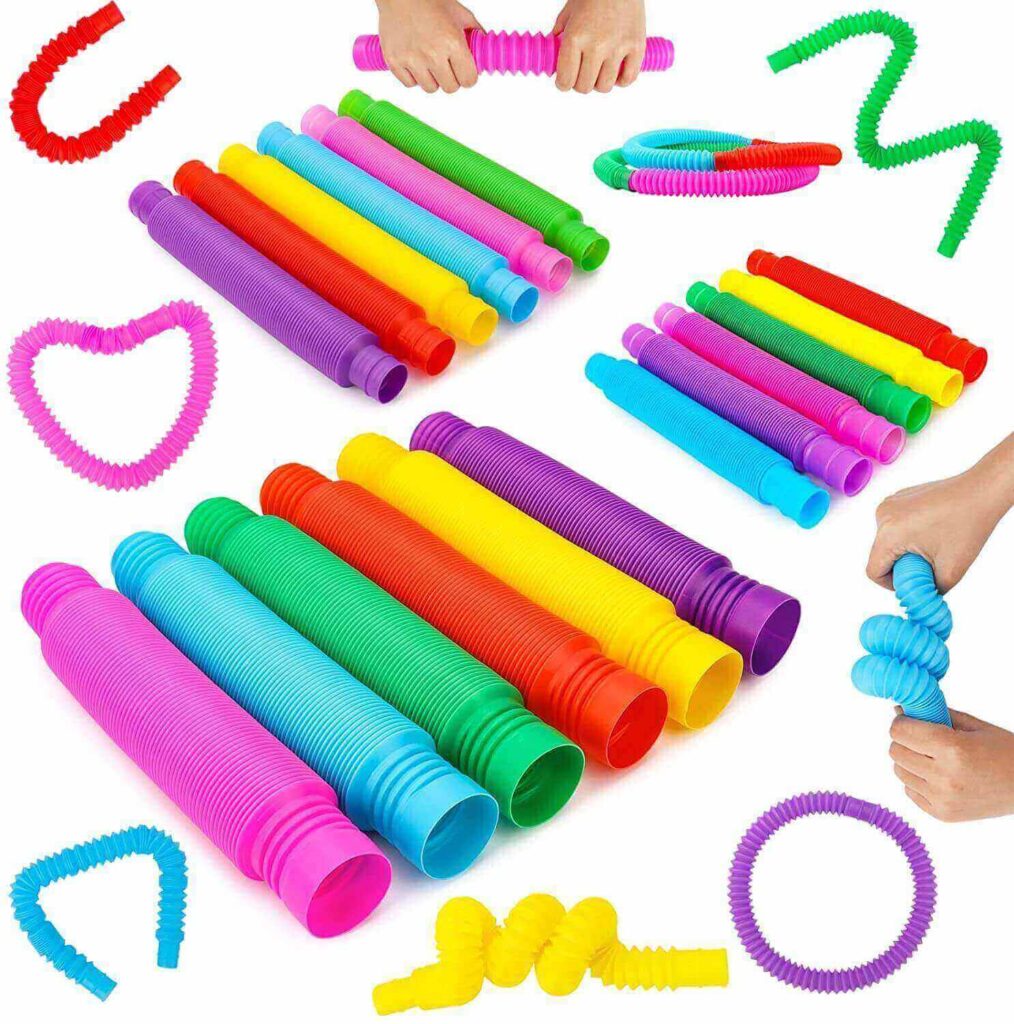
Pop Tubes Toy for Bilateral Coordination– (affiliate link) Pop tubes can be used in many ways to work on bilateral skills. Use them for a fine motor bilateral coordination task, or use them to work on a large scale or small scale. Wrap one around a wrist and build off of that tube. Or create a chain of tubes. Hold one and drop objects through the tube and into a container. How will you use this bilateral coordination toy?
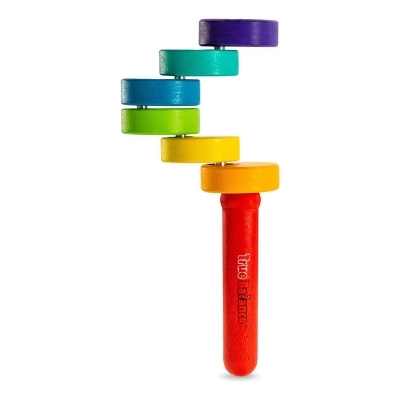
TruBalance Bilateral Coordination Toy– (affiliate link) This toy requires both hands as well as the eyes to challenge balance, coordination, and bimanual skills. Kids can work with this toy while sitting, standing, or in more challenging positions. Try incorporating couch cushions for a balance activity. Use this toy in a bilateral coordination obstacle course. Kids can use the pieces in a scavenger hunt type of activity where the parts are scattered at various levels and positioning, allowing the child to crawl, climb, walk, or squat while balancing the toy. The options go on and on!
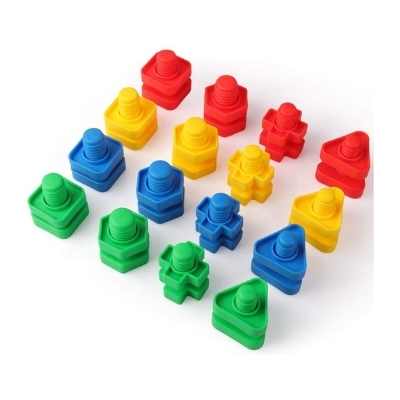
Nuts and Bolts Bilateral Coordination Toy– (affiliate link) This nuts and bolts activity is great for developing fine motor skills as well as bilateral coordination by requiring the child to use one hand to manipulate the parts while the other hand acts as a stabilizer. This is a nice way to develop skills needed for tasks like handwriting, pouring, stabilizing, cooking, etc.
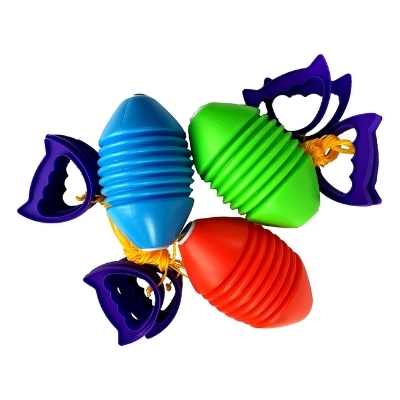
Zoom Ball– (affiliate link) This classic toy is such a great way to work on many skills: bilateral coordination, core strength, shoulder stability, visual convergence, motor planning, and coordination. Just like the TruBalance toy, a zoom ball can be used in different positions to challenge balance and vestibular input: Try using the zoom ball in sitting, standing, kneeling, standing on couch cushions, a slant…again, the options are limitless! Use our favorite zoom ball games to get started.
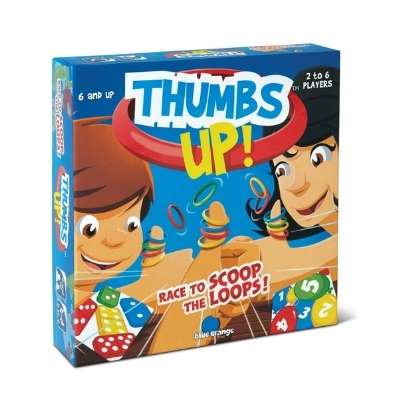
Thumbs Up Game– (affiliate link) This bilateral coordination game requires players to place rings on their thumb in a “thumbs up” position while they race to scoop and find the correct combination of colored rings to add to their thumb. It’s a fun racing game that builds visual perceptual skills too: figure ground, visual discrimination, visual memory, as well as the visual processing skill of scanning.
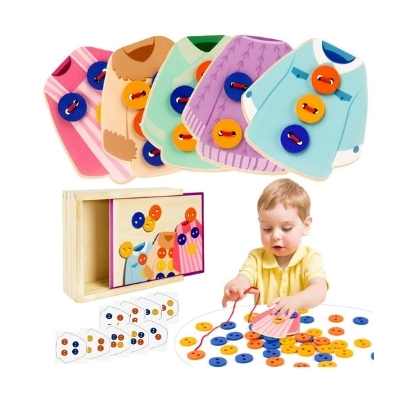
Lacing Buttons– (affiliate link) There is no doubt about the power of lacing cards when it comes to developing bilateral coordination skills. However, this lacing buttons activity takes it up a notch with the eye-hand coordination and visual processing skills. Kids can lace buttons onto wooden shirt pieces while building bilateral skills, fine motor skills, and eye-hand coordination. However, the set also includes puzzle cards that ask the child to lace on colored buttons in specific order so it matches the cards. What a workout in visual processing skills, too!
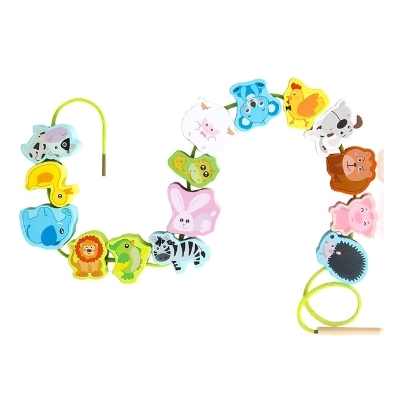
Animal Lacing Beads– (affiliate link) These lacing beads are chunky wooden animals that help kids develop bilateral coordination, eye-hand coordination, fine motor skills, and visual perceptual skills. As an occupational therapist, I am drawn to this toy because of the different animals that could be used in sequencing activities, sensory bins, pretend play, stacking activities, and so much more.
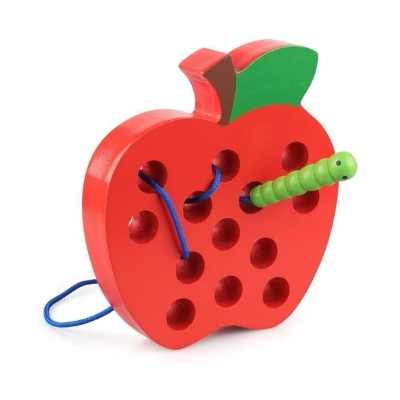
Wooden Lacing Apple– (affiliate link) This lacing puzzle challenges bilateral coordination skills and can be used to work on eye-hand coordination, tripod grasp, and motor planning. Use this activity to help with stabilization as well.
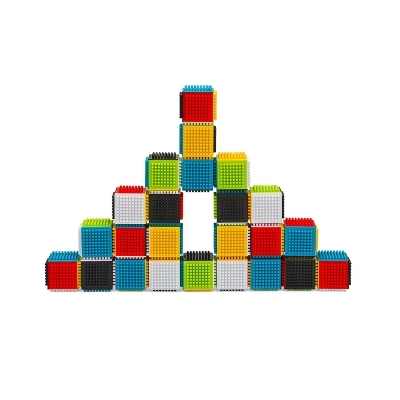
Press and Stay Blocks– (affiliate link) These building blocks require bilateral coordination with a press so they stay, helping kids to develop bilateral coordination and get proprioceptive input to push them together and then take them apart. Building blocks are a great way to build fine motor skills and visual perceptual skills, and these are a great addition to your therapy toolbox collection.
Labyrinth Game– (affiliate link) This maze game is a favorite in our house, and a tool for building bilateral coordination and visual perceptual skills too. Kids need to manipulate two knobs at the same time and coordinate visual information with one hand or the other…or both. It’s a brain building challenge that involves both sides of the body. Challenge kids to do this activity in a kneel or while standing on their knees at a low table to challenge balance and offer proprioceptive input as well.
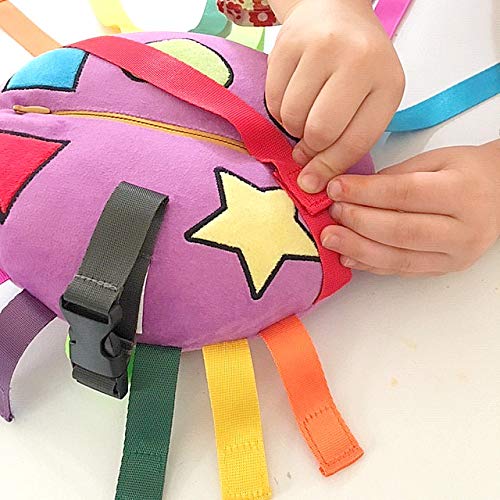
Octi Buckle Plush Toy with Hook and Loop Straps– (affiliate link) This play toy is a strategy to encourage development of fine motor skills, problem solving, color matching, coordination, and more. This stuffed play buddy is a toy that promotes development of many skills, bilateral coordination being one of them.
Using toys that double as quiet time activities, busy bags, or travel toys…all while working on skills is what makes toys like the buckle plush toy a therapist-approved toy. A buckle toy, with bright colors, shapes, straps, and zipper pouch will provide countless hours of recognition activities, brain building games and development puzzles. Your little one will stay busy counting the number of straps, connecting them together, pulling them apart, and starting over again. Kids can hide small items and treasures in the zip pouch, then unzip it later and get excited over their discovery!
More Bilateral coordination activities
Amazon affiliate links are included below.
- Melissa & Doug Pop Blocs Farm Animals
- Brain Development Bilateral Coordinate Training Set
- Nuts and Bolts Toys
- Creative Construction STEM Building Toys
- Brain Flakes Interlocking Plastic Disc Set
Some of the smartest and most creative folks I know are the readers of The OT Toolbox. I asked readers to tell me sensory strategies they personally love and use to address sensory modulation. Scroll through the comments…you might just find some new sensory strategies that will work for you! Hopefully we can learn from one another!
Also, check out these other soy suggestions based on therapeutic development through play.
- Fine Motor Toys
- Gross Motor Toys
- Pencil Grasp Toys
- Toys for Reluctant Writers
- Toys for Spatial Awareness
- Toys for Visual Tracking
- Toys for Sensory Play
- Bilateral Coordination Toys
- Games for Executive Functioning Skills
- Toys and Tools to Improve Visual Perception
- Toys to Help with Scissors Skills
- Toys for Attention and Focus
Printable List of Toys for Bilateral Coordination
Want a printable copy of our therapist-recommended toys to support bilateral coordination?
As therapy professionals, we LOVE to recommend therapy toys that build skills! This toy list is done for you so you don’t need to recreate the wheel.
Your therapy caseload will love these BILATERAL COORDINATION toy recommendations. (There’s space on this handout for you to write in your own toy suggestions, to meet the client’s individual needs, too!)
Enter your email address into the form below. The OT Toolbox Member’s Club Members can access this handout inside the dashboard, under Educational Handouts. Just be sure to log into your account, first!

Colleen Beck, OTR/L has been an occupational therapist since 2000, working in school-based, hand therapy, outpatient peds, EI, and SNF. Colleen created The OT Toolbox to inspire therapists, teachers, and parents with easy and fun tools to help children thrive. Read her story about going from an OT making $3/hour (after paying for kids’ childcare) to a full-time OT resource creator for millions of readers. Want to collaborate? Send an email to contact@theottoolbox.com.

